Useful Tree Species for Tree-Ring
Dating
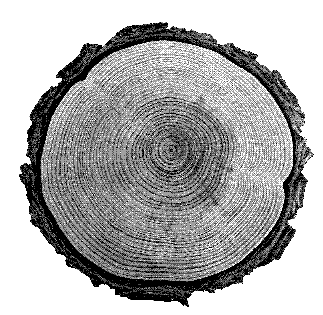 This is a
cross-section of a Douglas-fir (Pseudotsuga
menziesii) from the Catalina Mountains north of Tucson,
Arizona. The sample shows excellent ring-width variability from one
ring to the next. The inner ring on this sample has been dated to
1928, and the outer ring dated to 1965.
This is a
cross-section of a Douglas-fir (Pseudotsuga
menziesii) from the Catalina Mountains north of Tucson,
Arizona. The sample shows excellent ring-width variability from one
ring to the next. The inner ring on this sample has been dated to
1928, and the outer ring dated to 1965.
Douglas-fir is one of the preferred species for dendrochronology
in the western portions of North America. The species has
exceptional circuit uniformity, meaning that the rings are usually
concentric around the middle. The rings are also well defined - in
other words, there is a sharp definition between the earlywood
(wood formed early in the growing season) and latewood (wood formed
later in the growing season). In addition, Douglas-fir is well
distributed from Canada all the way down to northern Mexico, making
this an ideal species for large-scale climate reconstructions.

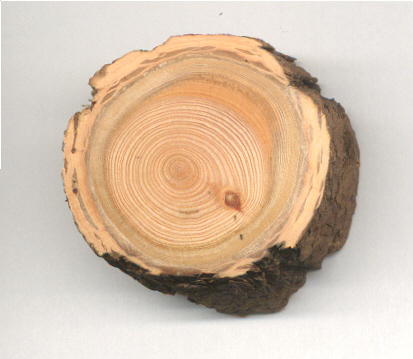
The cross-section below is a Douglas-fir from the Jemez Mountains
in northern New Mexico, showing darker bands of reaction
wood(toward the top right corner). Reaction wood forms when a tree
tilts. There are many elements that may cause a tree to tilt, like
wind and snow. The sample also shows a branch growing from the
center of the tree outward (dark spot toward the bottom right
corner).
Comparing the two samples, which are about the same size around,
we see that growth conditions were more favorable for the white fir
than for the Douglas-fir, because of the wider rings. The
Douglas-fir was growing in a closed canopy (a forest overshadowed
by bigger trees), while the white fir was growing in a relatively
open area exposed to more sun and water.
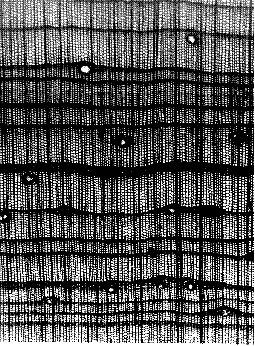
This image shows a closeup of ponderosa pine (Pinus
ponderosa) tree rings. Growth is from the left to right.
Earlywood is marked by lighter colored cells, while latewood is
marked by the dark bands. Together, they make up one annual tree
ring.
Note the subtle false rings in the fourth ring from the left and
in the fifth ring from the right. These two examples are not so
obvious, but sometimes in certain tree species growing in certain
environments, false rings can look just like true rings. Without
training in crossdating, false rings can be problematic when
attempting to crossdate tree ring patterns. False rings can usually
be identified during the crossdating process. Sometimes, they can
actually aid in the crossdating process if the false rings occur in
numerous trees sampled from a site.
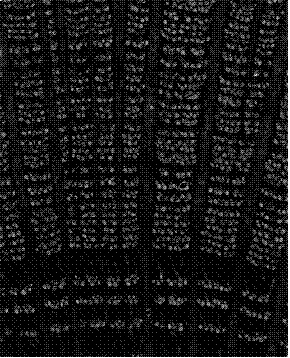
This is a cross-section of post oak (Quercus
stellata) showing its tree rings. Growth is from left to
right.
Note the difference in growth patterns between the four younger
rings to the left and the older rings to the right. During the year
in which the fourth ring from the left formed, some disturbance
occurred which greatly reduced the growth rate of this tree.
Perhaps a wind storm damaged the crown of the tree, thus reducing
its ability to photosynthesize and produce more wood.
Oak is a highly preferred species to use in dendrochronology - in
fact, the longest continuous tree-ring chronology anywhere in the
world was developed in Europe and is currently about 10,000 year in
length. This chronology is providing scientists new insights on
climate over the past 10,000 years, especially at the end of the
last Glacial Maximum.
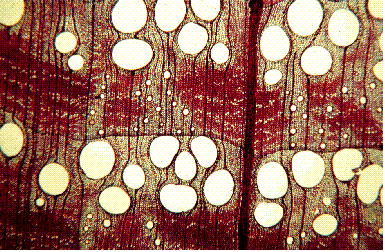
This is a microphotograph of two red oak (Quercus
rubra) tree rings. Growth is from the left to the right.
The large vessels in the earlywood indicate this is a ring-porous
angiosperm tree species.
The large earlywood vessels are formed early in the spring during
the initial flush of growth that occurs when the tree breaks
dormancy after the winter. The vessels help transport water and
nutrients up to the crown of the tree.
Because ring-porous species almost always begin annual growth with
this initial flush, missing rings are rare in such species as oak
and elm. In fact, the only recorded instance of a missing ring in
oak trees occurred in the year 1816, also known as the Year Without
a Summer. A volcanic eruption in the year 1815 caused much cooler
temperatures globally, thus causing oak trees to remain dormant.
Therefore, no clear annual ring was formed in 1816 for certain
locations in Europe.
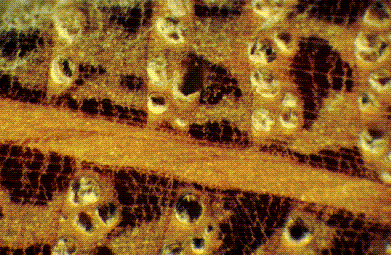
This is another closeup of post oak with a ray cutting across the
tree rings, offsetting the rings between the ray. The earlywood is
marked by large vessels used in conducting water. Latewood appears
darker, marked by smaller vessels. Occasionally, offsets in oak
tree rings can be problematic when trying to crossdate the rings.
Dendrochronologists therefore must be careful when working with oak
species, as these rays can cause a misdate of one year.
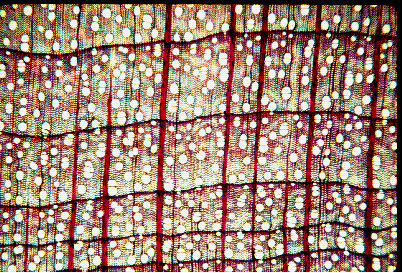
A closeup of tree rings from a sugar maple (Acer
saccharum). Growth is from the left to the right. The small
vessels throughout the entire tree ring indicates this is a
diffuse-porous angiosperm species.
In general, diffuse-porous trees are difficult to crossdate
because the rings are not so well defined as they are with conifer
and ring-porous species. The maples and birches
(Betula spp.) are examples of diffuse-porous species
that can be easily dated, however. The aspens and other poplars
(Populus spp.) are more difficult to work with. With
careful sample collection and preparation techniques, tree-ring
dating can be applied to practically all diffuse-porous species.
A ll graphics and text on these pages © 1996
by Lori Martinez, Laboratory of Tree-Ring Research, and The
University of Arizona. Last updated October, 2001. All rights
reserved.
 This is a
cross-section of a Douglas-fir (Pseudotsuga
menziesii) from the Catalina Mountains north of Tucson,
Arizona. The sample shows excellent ring-width variability from one
ring to the next. The inner ring on this sample has been dated to
1928, and the outer ring dated to 1965.
This is a
cross-section of a Douglas-fir (Pseudotsuga
menziesii) from the Catalina Mountains north of Tucson,
Arizona. The sample shows excellent ring-width variability from one
ring to the next. The inner ring on this sample has been dated to
1928, and the outer ring dated to 1965.




